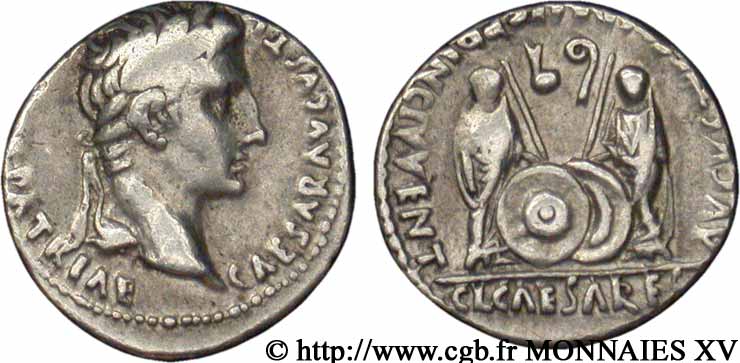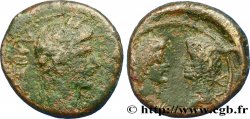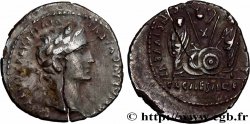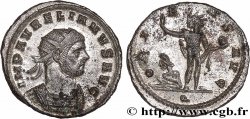v15_1502 - AUGUSTUS, CAIUS und LUCIUS Denier
MONNAIES 15 (2002)
Startpreis : 90.00 €
Schätzung : 180.00 €
Erzielter Preis : 90.00 €
Anzahl der Gebote : 1
Höchstgebot : 90.00 €
Startpreis : 90.00 €
Schätzung : 180.00 €
Erzielter Preis : 90.00 €
Anzahl der Gebote : 1
Höchstgebot : 90.00 €
Type : Denier
Datum: 2 AC. - AD. 2
Name der Münzstätte / Stadt : Gaule, Lugdunum, (Lyon)
Metall : Silber
Der Feingehalt beträgt : + 900 ‰
Durchmesser : 18,5 mm
Stempelstellung : 2 h.
Gewicht : 3,60 g.
Kommentare zum Erhaltungszustand:
Beau portrait. Flan légèrement court des deux côtés. A été légèrement nettoyé. Revers bien venu à la frappe
N° im Nachschlagewerk :
Vorderseite
Titulatur der Vorderseite CAESAR AVGVSTVS - DIVI F PATER PATRIAE.
Beschreibung Vorderseite Tête laurée d'Auguste à droite (O*).
Übersetzung der Vorderseite “Cæsar Augustus Divi Filius Pater Patriæ”, (César Auguste fils du divin Jules, père de la patrie).
Rückseite
Titulatur der Rückseite C. L. CAESARES À L'EXERGUE/ AVGVSTI F COS DESIG PRINC IVVENT.
Beschreibung Rückseite Caius et Lucius Césars debout de face, vêtus de la toge, tenant chacun un bouclier rond et une haste ; simpulum à gauche, le lituus à droite.
Übersetzung der Rückseite "Caius et Lucius Cæsares/ Augusti filii consules designati Principes Iuventutis" (Caius et Lucius Césars, fils d'Auguste, consuls désignés, princes de la jeunesse).
Kommentare
C’est l’un des deniers les plus courants de l’atelier de Lyon. C’est aussi l’une des pièces qui se rencontre le plus souvent en Gaule. C’est encore l’un des deniers qui ont été le plus imités aussi bien dans les limites de l’Empire qu’en dehors du limes. Le denier représentant les deux petits-fils d’Auguste eut un succès considérable en Gaule. Nous devons modifier notre vision de la circulation monétaire entre la fin de la guerre des Gaules et la mort de Néron en 68 après J.-C. Monnaies gauloises en argent, en bronze et en potin circulèrent conjointement avec les monnaies romaines qui se répandirent largement en dehors de la Narbonnaise. Il faut évoquer le néologisme de circulation “romano-gauloise” plutôt que gallo-romaine.
This is one of the most common denarii from the Lyon mint. It is also one of the coins most frequently found in Gaul. It is still one of the denarii that has been most imitated both within the limits of the Empire and outside the limes. The denarius representing the two grandsons of Augustus had considerable success in Gaul. We must modify our view of monetary circulation between the end of the Gallic Wars and the death of Nero in 68 AD. Gallic coins in silver, bronze, and potin circulated alongside Roman coins, which spread widely outside Narbonne. We must mention the neologism of circulation “Romano-Gallic” rather than Gallo-Roman
This is one of the most common denarii from the Lyon mint. It is also one of the coins most frequently found in Gaul. It is still one of the denarii that has been most imitated both within the limits of the Empire and outside the limes. The denarius representing the two grandsons of Augustus had considerable success in Gaul. We must modify our view of monetary circulation between the end of the Gallic Wars and the death of Nero in 68 AD. Gallic coins in silver, bronze, and potin circulated alongside Roman coins, which spread widely outside Narbonne. We must mention the neologism of circulation “Romano-Gallic” rather than Gallo-Roman








 Berichten über einen Fehler
Berichten über einen Fehler Die Seite drucken
Die Seite drucken Teilen meiner Auswahl
Teilen meiner Auswahl Stellen Sie eine Frage
Stellen Sie eine Frage Einlieferung/Verkauf
Einlieferung/Verkauf
 Details
Details















